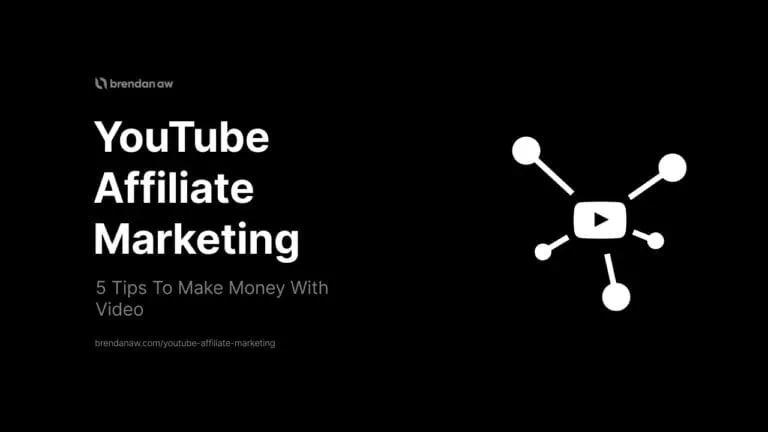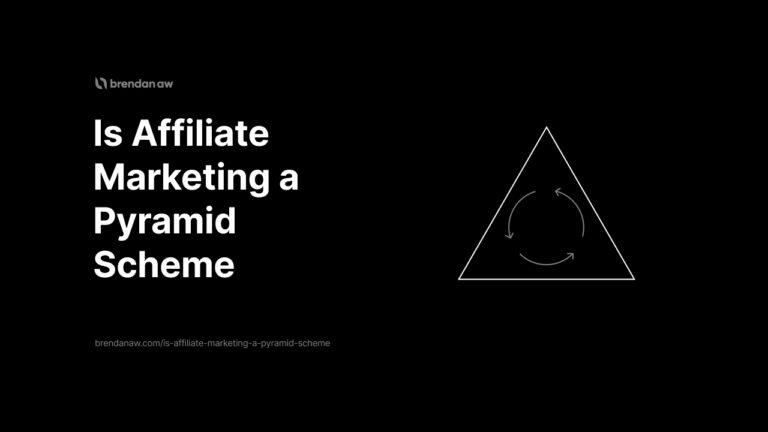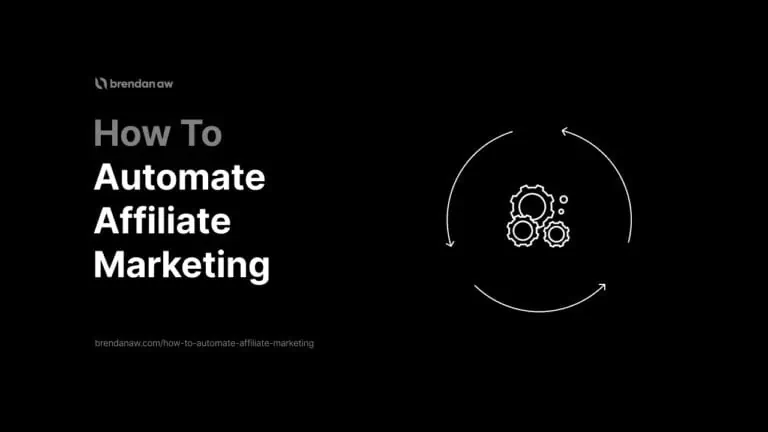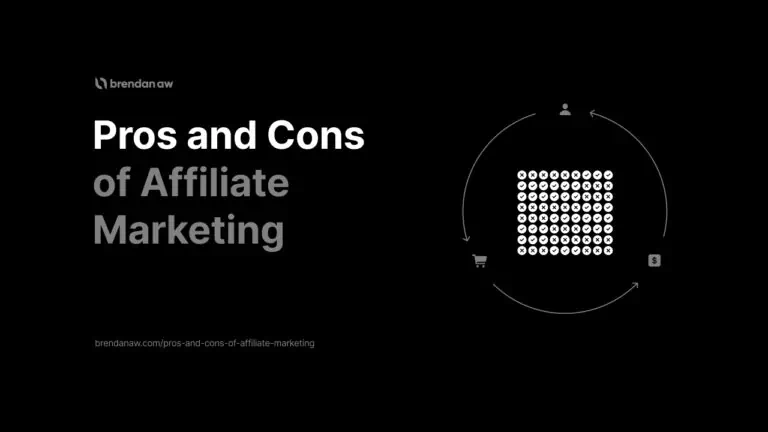Can you do affiliate marketing without a website?
Yes. Absolutely.
In fact…
That’s how everyone did it in the early days.
And many of these methods continue to be effective today.
You’ll learn:
- The pros and cons of affiliate marketing without a website
- My top methods to start affiliate marketing without one
- Some extra tips for you at the end
Let’s go.
Pros of Affiliate Marketing Without a Website
Having your own website can benefit you in several ways — more so in affiliate marketing.
But… skipping this step and using alternative traffic sources can be just as beneficial.
Here’s how:
Quick Methods To Reach Your Audience
Building a website is a huge undertaking.
It’s one thing to build your site…
It’s another getting it on people’s radars.
Getting your content to rank on the first page of SERPs can take months.
There are much faster ways to reach your target audience, like:
- Paid ads
- Posting on online forums
- Guest posting
The sooner you can put your affiliate links out there, the sooner you can start making money.
Cost Effective
You need anywhere between $1,500 to $5,000 to build a website (if you outsource it)…
Plus an additional $50 to $1,000 a month for maintenance costs.
What if I told you…
You can still reach your target audience without spending a dime?
Social media platforms are a good example.
I don’t know anyone today who doesn’t have at least one social media account.
So tap into these giant free networks and rake in a following.
Targeted Audience
Another advantage of doing affiliate marketing on social media is algorithmic targeting.
Algorithms are the backbone of all social media platforms.
These help you put your content in front of your target audience.
Who are they?
- Users interested in your promoted products or services
- Users who search for solutions addressed by your promoted products or services
- Users with high purchasing power
- Users who frequently purchase through similar content
You can easily reach the right people as long as you post consistent and high-quality content.
Most major social media platforms also give you access to various tools to track your engagement.
Content Monetization
Many online platforms let you monetize your content.
For example:
- Social media: Facebook, Instagram, X (Formerly Twitter)
- Online forums: Reddit and Quora
- Long-form content-sharing sites: YouTube and Medium
This means you make money every time someone views your content regardless of whether they purchase through your links.
Monetized content + affiliate marketing…
That’s a winning combo for content creators like you.
Cons of Affiliate Marketing Without a Website
The problem with not having a website is it limits your options.
For instance…
Many affiliate programs require affiliates to have their own website.
Here are other cons you should consider:
Scattered Marketing Efforts
A website serves as a home for all of your content and marketing efforts.
You can use it to:
- Share content
- Build an email list
- Sell your own products and services
Without this…
You will have to use a variety of traffic sources and tools which can cost you a lot of time and money.
Reduced Credibility
Having a website (or at least a custom domain) adds credibility to your links.
Let me demonstrate:
Between these two links, which one would you click?
- This one? https://gsdt456a.net/tgyg46#4_dH@ju5kr
- Or this one? brendanaw.com/go/product-1
Today’s consumers are smart, and they are wary of links that look spammy.
So either get a website…
Or cloak your links up.
Subject to the Rules of Other Platforms
Other platforms come with their share of rules and limitations.
For example…
- Instagram reels can only be 90 seconds long.
- Many Facebook groups and online forums don’t allow promotions.
- You’re also subject to constant algorithmic updates that can significantly impact your reach.
Having your own website gives you full control over exactly how you want to market your affiliate offers.
It’s YOU who makes the rules.
You’re Not Building an Asset
A fully developed website with decent traffic is a valuable asset…
And you can sell this for up to 40x its monthly revenue.
This is a neat endgame for most online businesses when they want to move on to other pursuits.
How To Do Affiliate Marketing Without a Website
There are several ways to do affiliate marketing without a website.
Here are some of the most highly effective methods you can look at:
1. Solo Ads
Solo ads date back to the early days of affiliate marketing.
How do these work?
You pay someone to send out an email campaign to their subscriber list on your behalf.
The main advantage of this is you can instantly target different audiences…
And earn commissions from day one (ideally).
But…
The drawback is you’re not guaranteed an audience match and quality since you’re relying on someone else’s email list.
This strategy can also get expensive.
Here’s how you can maximize your Earnings Per Click (EPC) with solo ads:
- Only purchase solo ads from reputable sources to protect yourself from spam, fraud, and timewasters.
- Make sure that your target email list is aligned with your specific product niche.
- Revisit your contract regularly.
2. PPC Ads
Pay-per-click (PPC) ads allow you to target wider audiences by placing your advertisements throughout an entire platform…
Not just someone’s email list.
It works like this:
For example, you want to place a PPC ad on Google for camping equipment. You need to…
- Set up a Google Ads account.
- Set your objectives.
- Choose a campaign type: Search, Display, Video, Shopping, or App
- Set the campaign specifics: Schedule, Location, Network, Budget
- Optimize your campaign.
- Launch.
Once you launch your campaign, Google will display your ad at the top and bottom of the search results page whenever someone searches for the keyword “camping equipment”.
It will look something like this:
PPC is not limited to Google…
You can also place PPC ads on social media platforms to expand your reach.
3. Retargeting
Retargeting involves showing ads to people who viewed your landing page or affiliate link but did not make a purchase.
It’s the final often-forgotten step in an affiliate marketing funnel.
Here’s how it works:
- Someone clicks on your landing page or link.
- A tracking pixel or “cookie” records their information.
- They leave the page without buying anything.
- You use their tracking info to show them more ads about the product.
- You wait for them to click on the new ad and (hopefully) make a purchase this time.
It works the same as PPC ads…
Just with the retargeting objective.
The beauty of retargeting ads is you get 10x the CTR of regular ads because you’re targeting audiences that already displayed their interest.
4. Online Communities and Forums
Another way you can promote your links without a website or spending money is by posting on online forums and communities like Reddit and Quora.
Reddit alone has 861 million monthly active users across over 130,000 subreddits.
More than 400 million users visit any one of over 100,000 spaces on Quora every month.
There’s a community you can join regardless of what affiliate marketing niche you’re in, whether that’s gaming…
…Or long furbies (???)
I don’t even know what that is but you can bet it exists.
But here’s the caveat…
You can’t directly post affiliate links in both Reddit and Quora.
But links to external blog posts are allowed.
So do these instead:
- Answer questions but don’t give away all the secrets
- Direct users to your affiliate posts in the body
- Pin affiliate articles on your Reddit and Quora profiles
5. Content Publishing Platforms
You don’t need a website to share more structured content like articles and blog posts…
Just post them on content publishing platforms.
Medium is one of the biggest content publishing platforms out there with over 138 million visitors every month.
Steemit is another option with 4.2 million monthly visitors.
These platforms feature built-in tools you can use to track engagement and optimize your marketing strategies.
Here’s how you can be a successful affiliate on these platforms:
- Create an account for free.
- Write content that addresses your target audience’s pain points and offers solutions.
- Include affiliate links a couple of times throughout the article.
- Include an affiliate disclosure as required by law.
- Optimize your content for SEO.
- Hit “publish”.
6. Guest Posting
This involves sharing content on someone else’s platform.
But instead of general websites…
You’re posting on high-traffic sites within your niche.
This means you can reach a more targeted audience who are more likely to click on the affiliate links.
You can guest post in three ways:
- Pay the website: This is often the case if you have little authority and brand in the niche and you’re eyeing a high-ranking site.
- Exchange backlinks: You can guest post without spending money if you place links to their content on your own website.
- Get paid to guest post: Sites may pay you to write guest posts for them if you’re a leading authority in your niche.
7. Email Marketing
Email remains one of the highest-converting affiliate marketing methods.
You need three things to achieve this:
- An email marketing software: Use autoresponders to create and track email campaigns. ConvertKit is my preferred option for creators.
- An email list: You can either buy email lists or build your own from scratch. Buying an email list lets you reach an audience quickly but there’s no guarantee that these people will be interested in your affiliate products.
- A landing page: This is where people can subscribe to your mailing list. You need a strong call to action (CTA) and a compelling offer to encourage them to sign up.
8. E-Books/ Lead Magnets
This is the compelling offer I’m talking about.
Lead magnets are valuable pieces of content that people will want to gain access to because they provide genuinely useful information.
To create a high-converting lead magnet:
- Use Google Trends to find trending topics in your niche.
- Choose a topic you’re well-versed in.
- Write a 3000+ word ebook.
- Embed your links organically.
You can also do other giveaway campaigns like free products and services or discount codes.
9. Social Media
Social media is one of the most common free traffic sources for affiliate marketing.
It’s probably the best way for beginners to start affiliate marketing without a website.
Look at it this way:
- It’s free.
- There are virtually no barriers to entry.
- Over half of the world’s population has at least one social media account.
You just need to be consistent in sharing quality content and engaging with your audience to build a decent following.
That said…
It’s important to choose the right platform for your niche and marketing goals.
I recommend:
- Facebook for all types of B2C and B2B products and services
- Instagram for lifestyle and fitness products
- TikTok for everyday needs and trending products
- X (formerly Twitter) for tech brands, games, gadgets, and business software
- LinkedIn for courses, workshops, and professional services
- Pinterest for visual niches like home decor, fashion, and photography
10. YouTube Channel
Another highly effective way is YouTube affiliate marketing.
That’s because YouTube is both a search engine and a social media platform.
This comes with certain key advantages like:
- More than 2.7 billion active users across all demographics
- Hosts both evergreen content (long-form videos) and trending content (YouTube shorts)
- Video is the preferred content format of the future. According to a recent survey, 85% of marketing professionals agree that videos help generate leads.
When it comes to affiliate marketing…
It’s important to create a variety of content types including:
- Product reviews and comparisons
- How-to guides
- Unboxings
- Best-of videos
And don’t forget to include your links in the description.
11. Podcasts
Podcasts are steadily increasing in popularity.
60% of consumers in the US alone listen to podcasts as of 2022.
This is perhaps because audio formats are easier to consume and require a lower level of engagement compared to, say, reading an article or watching a video.
That said…
The lack of a visual aspect also makes it trickier to convey your affiliate links.
I recommend creating a linktree to host all your links and promotions that you can mention in every one of your podcasts.
12. Offline Efforts
Various marketing methods existed way before the internet.
And they can still be effective today.
Offline affiliate marketing demands significant effort but boasts a high conversion rate due to one-on-one engagement with the target market.
Some examples of offline marketing methods include:
- Networking
- Telemarketing
- Word of mouth
- Print advertising
- Product catalogs
I’ve never tried any of these because there’s gonna be a lot more friction trying to get link clicks.
But if you see success with them, let me know!
Tips for Affiliate Marketing Without a Website
If you want to do affiliate marketing without a website…
I recommend doing these things to optimize your marketing efforts and maximize your ROI:
- Diversify your traffic sources: Using only one of the marketing methods above likely won’t give you the kind of revenue you want. Combine a few of these methods to target more audience segments and get more conversions.
- Choose the right platforms: Not all platforms will work for your niche. For instance… email marketing works best for an older demographic while social media taps the younger generation.
- Give it a chance to work: It takes time to build traffic with or without a website. Getting 1,000 followers online can take weeks if not months. You need patience and consistency if you want to see the results of your efforts.
- Ditch what doesn’t work: Alternatively… If something clearly isn’t working, adjust your strategy or scrap it altogether and come up with a new one.
- Spend wisely: Make sure that any expense you make generates a decent ROI. For example… It doesn’t make sense to buy PPC ads that cost $5 per click if you’re promoting a product that costs $50 with a 5% commission rate.
Affiliate Marketing Without a Website (FAQs)
Which Affiliate Programs and Networks Do Not Require a Website?
Many affiliate programs and networks don’t require affiliates to have their own website.
These include:
• Amazon Associates
• eBay Partner Network
• Share A Sale
• ClickBank
• Refersion
• Rakuten
• Awin
Do I Need a Domain for Affiliate Marketing?
No. You can use your link as is and share that with your audience.
However…
Having a custom domain to cloak your links can make them look more credible and encourage more clicks.
Cloaked links also protect you from link hijacking and keep your commissions safe.
How Do I Promote My Affiliate Landing Page Without a Website?
There are several ways you can promote your affiliate landing page without a website.
For example:
• Use it as your link in bio on social media
• Display a short link within your videos
• Put the link in your post captions or video descriptions
• Buy PPC ads that link to your affiliate landing page
Can You Make Money With Affiliate Marketing Without a Website?
Yes. There are various free and paid traffic sources you can use to promote your affiliate links without using a website.
These include:
• Email marketing
• Online forums
• Social media
• Paid ads
These can be just as effective and cost-efficient when starting affiliate marketing.
What Is the Easiest Way To Promote My Affiliate Links Without a Website?
Buying PPC ads is the easiest and fastest way to promote your affiliate links.
Paid ads get you instant traffic without having to create a huge bank of content and build an audience.
You can start earning as soon as you launch an ad campaign.
But.
Commissions will almost immediately dry up once the ads stop.
Don’t rely on it as your primary source of traffic.
Use it to supplement a strong organic strategy.
How Can PPC Marketing Help Me To Become a Successful Affiliate Marketer Without a Website?
PPC marketing allows you to advertise your affiliate products on search engines like Google.
You bid on keywords related to your product…
And when these keywords are searched, your ad can appear in the results.
You earn a commission when a user clicks on your ad and purchases with your link.
Do I need to make sure of anything specific before starting affiliate marketing without a website?
Yes, ensure the affiliate programs you choose allow you to promote products without a website.
Many do, but more popular and reputable brands will require you to have one.
To Sum Up
See…
Becoming an affiliate marketer without a website is 100% possible.
You only need a traffic source to promote your links and earn commissions.
There are many different ways you can do this.
You can:
- Buy ads
- Post on online forums and content publishing platforms
- Guest post on other websites
- Do email marketing
- Offer lead magnets
You can also start a social media account, YouTube channel, or podcast.
The most important thing?
Putting out great affiliate content.













